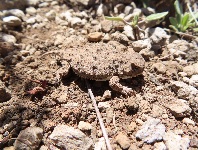Pygmy Short-Horned Lizard (Phrynosoma douglasii)
Description: The pygmy short-horned lizard is often mistaken for its close relative the greater short-horned lizard (P. hernandesi) which has the same basic body type consisting of small pointed scales around the head and back. Until recent mitochondrial DNA evidence, the greater short-horned lizard was considered to be the same species as the pygmy short-horned lizard. They are now considered distinct species with the pygmy short-horned lizard occupying the northwest portion of the United States and extreme southern British Columbia. When placed together the two are easily distinguished at full size, the pygmy short-horned lizard being much smaller. The greater short-horned lizard is a highly variable species with different geographic populations exhibiting differences in colour, pattern, and size, with some authorities describing five subspecies.
The pygmy short-horned lizard ranges in size from 1.25–2.5 inches in snout-to-vent length (SVL) and is a flat-bodied, squat lizard with short spines crowning the head. It has a snub-nosed profile and short legs. The trunk is fringed by one row of pointed scales, while the belly scales are smooth. The colour is gray, yellowish, or reddish-brown, and there are two rows of large dark spots on the back. When threatened or aggressive, its colours become more intense.
Habitat: This lizard ranges from semiarid plains to high mountains: sagebrush, bunchgrass, pinyon-juniper woodland, openly spaced pines. Usually it occurs in open, shrubby, or openly wooded areas with sparse vegetation at ground level. Soil may vary from rocky to sandy. When not active on the surface, the lizards burrow into the soil or occupy rodent burrows.
Range: This species occurs in the northwestern United States, and formerly in southwestern Canada. It ranges from southern British Columbia south to northeastern California, northern Nevada, and southern Idaho; eastern and southern range limits have not been precisely determined; there is an old record from extreme southwestern Montana, where current status is unknown. Its elevational range extends from around 1,000 to 6,000 feet.
Diet: The diet of P. douglasii varies from different habitats, but mostly among age and sex classes; neonates feed among almost exclusively on ants (89%) while adults consume fewer ants (72%) and yearlings consume the lowest proportion of ants (60%).
Reproduction: Gives birth to 3-15 young, mainly August to mid-September. Sexually mature in 2 or more years
Status: Listed as Least Concern in view of its wide distribution, presumed large population, and because it is unlikely to be declining fast enough to qualify for listing in a more threatened category.
»» Kingdom: Animalia - Animals
»» Phylum: Chordata - Chordates
»» Subphylum: Vertebrata - Vertebrates
»» Class: Reptilia - Reptiles
»» Order: Squamata - Lizards
»» Family: Phrynosomatidae - North American Spiny Lizards
»» Genus: Phrynosoma
»» Species: Phrynosoma douglasii - Pygmy Short-Horned Lizard
»» Subspecies: None
This article uses material from the Wikipedia article "Pygmy Short-Horned Lizard", which is released under the Creative Commons Attribution-Share-Alike License 3.0. Content may have been omitted from the original, but no content has been changed or extended.
|








